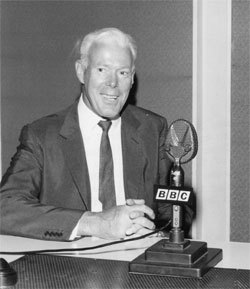Description 15 June1981
Trevor Leggett was head of the Japanese Department of the BBC.

This is one of his broadcasts to Japan
ZUBARI for 15 June,1981
Description
Hello listeners! I am now, after three weeks, once again acclimatized to the time differences between London and Japan.
Looking over my notes of my recent visit, I find that in reading the account of a Shogi match (part of one of the great tournaments, in fact the Meijin-sen) between Nakahara and Kiriyama in the Mainichi, I noted down some of the comments made in the Mainichi, of 20.5.81. It said, “…Kiriyama ga aeki wo tatta. Dai ikkyoku kara shiro-tabi de aru. Nakahara wa Kuro-tabi. Ryosha, seisō da ga, ashi dake chigatte ita. Shirotabi de mo Kurotabi de mo ii, katsu no ga ii tabi da to wa san mo iwanakatta ga, taitoru de shirotabi wo mita no wa hisashiburi no ki ga aru.” I was a keen shogi player once, though I no longer play much, and I have visited a number of championship matches.
The first one was nearly thirty years ago – it was Kimura against Masuda, I remember that Kimura was wearing a Western suit, and Masuda was in hakama. I thought at the time that it was curious that the younger man, Masuda, should be wearing the traditional costume. I had supposed that it would soon die out. But that has not happened, and perhaps it is a very good thing that so many of the Japanese players still keep up the old traditions. It helps to give a country an identity.
Nakahara is a young man, and I recently saw one of his championship games. He was in haori and hakama. As a matter of fact, to a Western eye it looks very impressive. But probably I am prejudiced, because, on that occasion, he signed for me a certificate awarding me a Go-Dan at Shogi. I cannot say that I think I am really a Go-Dan in contest ability – perhaps I am a Second Dan by that standard. But I have written a book on Shogi in English which is still the only one so I can say that I have done quite some service to spreading the popularity of the game abroad,
That certificate was written out – not by a professional calligrapher – but by Masaharu Oyama himself. About twenty years ago he gave me some lessons in Shogi, and I have met him over the years since.
I understand it is very rare that a certificate should be written by one of the great champions, and I shall keep it as a treasure of my house. This is not only for its value as a diploma, but also for the beautiful calligraphy of Master Oyama.
One of the things I want to say here is, that the description of the players and their dress – white tabi and black tabi – would never appear in a Western chess column. There would be nothing but the moves, and an analysis of them. But the Japanese chess columns always have some little description of the players, and perhaps the room and the climate weather. It seems to show that there is a special interest in human relations among Japanese people, which is lacking in the West.
Even in a special magazine of chess, there is no description of the players. As a comparison, I have looked through an article in the British magazine called CHESS, about the first visit of a Western chess team to China. It is a long article, covering four pages, and nearly all of it is devoted to the games. The Chinese chess players seem to be very strong on tactics; sometimes however they were outplayed in strategy.
Though there was some brief account of the ‘bicycle rush’ in Shanghai, and a very short description of Canton and Peking, but there is nothing, absolutely nothing, about the Chinese players personally. There is praise for some of their remarkable successes, but we are not told whether they are young or old, nor what their professions are or whether they are professional chess players. Nothing!
When I compare this kind of reporting with the Japanese, I feel that the Japanese style is better. I should like to know something about those Chinese chess players. I wonder whether they will develop into rivals of the Russians, who at present have the highest standard of chess in the world. It is taught in all Russian schools.
A Soviet-China chess match would be a very keen affair!
Well, till next time,
Sayonara…
© Trevor Leggett